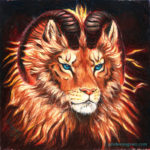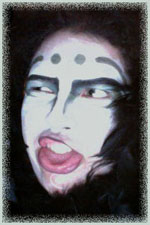 I want to begin this journal with two quotes, each from men far older and more accomplished than myself. The first is from George R. R. Martin, author of A Song of Ice and Fire series. It is called On Fantasy:
I want to begin this journal with two quotes, each from men far older and more accomplished than myself. The first is from George R. R. Martin, author of A Song of Ice and Fire series. It is called On Fantasy:
“The best fantasy is written in the language of dreams. It is alive as dreams are alive, more real than real … for a moment at least … that long magic moment before we wake.
Fantasy is silver and scarlet, indigo and azure, obsidian veined with gold and lapis lazuli. Reality is plywood and plastic, done up in mud brown and olive drab. Fantasy tastes of habaneros and honey, cinnamon and cloves, rare red meat and wines as sweet as summer. Reality is beans and tofu, and ashes at the end. Reality is the strip malls of Burbank, the smokestacks of Cleveland, a parking garage in Newark. Fantasy is the towers of Minas Tirith, the ancient stones of Gormenghast, the halls of Camelot. Fantasy flies on the wings of Icarus, reality on Southwest Airlines. Why do our dreams become so much smaller when they finally come true?
We read fantasy to find the colors again, I think. To taste strong spices and hear the songs the sirens sang. There is something old and true in fantasy that speaks to something deep within us, to the child who dreamt that one day he would hunt the forests of the night, and feast beneath the hollow hills, and find a love to last forever somewhere south of Oz and north of Shangri-La.
They can keep their heaven. When I die, I’d sooner go to middle Earth.”
Copyright © George R. R. Martin, circa 1996
It’s a profound statement, and one that I think well sums up what I find so fascinating about fantasy. It is on the whole more fun, more interesting, and more exciting, to write a story with dragons in it. It is quite like painting with color as opposed to sketching with pencil.
Or is it? There is something presumptive about the tone of that article that does not sit entirely well with me. As if my opinion is a hole of a particular shape, and this opinion does not quite fit. So let me turn to my second quote. This one is from Richard Dawkins, author of The Selfish Gene, The God Delusion, and The Blind Watchmaker, and other such works of staunch non-fantasy. But this quote doesn’t come from any of the aforementioned books. No, this I found in his most recent work, called The Magic of Reality, a children’s book illustrated by renowned fantasy artist Dave McKean. It comes from Chapter 1: What is Reality? What is Magic?
“The third meaning of magic is the one I mean in my title: poetic magic. We are moved to tears by a beautiful piece of music and we describe the performance as ‘magical’. We gaze up at the stars on a dark night with no moon and no city lights and, breathless with joy, we say the sight is ‘pure magic’ We might use the same word to describe a gorgeous sunset, or an alpine landscape, or a rainbow against a dark sky. In this sense, ‘magical’ simply means deeply moving, exhilarating: something that gives us goose bumps, something that makes us feel more fully alive. What I hope to show you in this book is that reality—the facts of the real world as understood through the methods of science—are magical in this third sense, the poetic sense, the good-to-be-alive sense.”
Copyright © Richard Dawkins, The Magic of Reality, Free Press, 2011.
I fall somewhere in between these two men. On the one hand I find dragons and magic far more interesting than engineering or math—but on the other hand I am astounded by dinosaurs. Dinosaurs, you see, may not have breathed fire or flown or spoken great truths and secrets, but they have this over dragons: dinosaurs actually existed. They are real. If you look at an infant bird you will see that, in a somewhat diminished capacity, they are still very much with us today—through the slow magic of evolution.
And this is where I diverge from George R. R. Martin: it is not so much that I see fantasy as an escape from a dull, clapboard reality, for I find that reality itself is often magical—magical in the sense that Dawkins describes. Where maybe he sees a noisy metal contraption filled with hot, unhappy people, I see a triumph of engineering and aerodynamics capable of hurtling through the Earth’s atmosphere at hundreds of miles per hour—and then coming safely down again. Something, I must point out, that cannot be said of Icarus.
There is a magic to reality, more solid and assured than any fantasy, because while a well-crafted fable can provide insight into the inner workings of the human predicament, reality has this: that is is real; that it exists with no effort of belief or of faith. It will exist no matter what we say or believe.
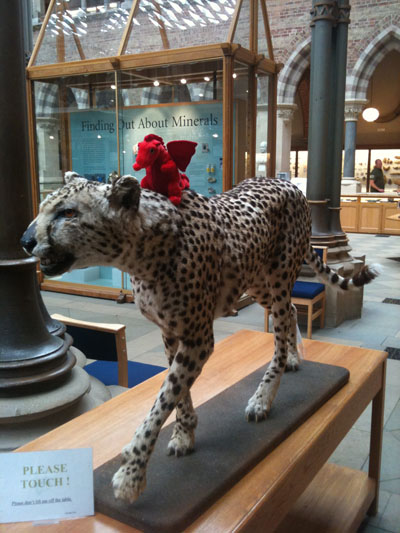
I stood on the fourth floor of the Natural History Museum in New York City, staring up at the Tyrannosaurus Rex skeleton. According to the plaque next to the display, these were not the actual fossils—they were too delicate to be mounted—but artificial copies. The huge skull, the size of the largest dog, that sat next to me, however, was genuine. It had teeth as long as my forearm.
There are lots of dragons in my imagination. Some of them did not exist until I dreamed them up. They are my friends, my muses, my entertainment. In a way, through the stories they interact with, they are my livelihood. They are real to me.
But they will never actually be. They will never cast shadows on the ground. They will never eat, never kill… never die. They will never walk.
This skull, and the animal it was originally part of, did. And that, to me, is more astounding and magical and marvelous than all the Silmarils of Féanor, all the talking animals of Narnia, all the wizards that ever were and will be.
We are made of atoms. And those atoms were forged in the crucible of the stars, spat forth into the universe to slowly congeal into planets and rocks and oceans… and life. According to genetics all forms life on Earth are “cousins.” But more than that, everything in this galaxy is made of the same basic stuff. We are all “star people” as Neil deGrasse Tyson likes to say.
Fantasy may be silver and scarlet, indigo and azure, but those things had to first exist in reality. Reality comes first, and always will be. Fantasy is the decoration, the magnifying glass that intensifies the colors and directs light into dark places we may be afraid to look. It is, as I like to say, the mirror by which we can see the wonders of our world reflected, refracted, concentrated and clarified.
There is a reason for fairytales: they teach us real things by showing us fantastical situations. Stories are immensely powerful, and can turn a jumble of otherwise unrelated facts (gene sequencing, dancing, camera obscuras, atomic bombs, protractors, martial arts) into one cohesive and memorable narrative (Anathem, by Neal Stephenson).
The real world, for all its wonder, is complicated and messy and emotionally torturous. That is where stories come in; stories are neat and tidy and help us find some sense and order in the chaos of reality. And fantasy stories are the most powerful of the lot, I think (and I am including sci-fi under the wing of fantasy here), because they tailor their own realities specifically for the purpose of the story they are telling. In a way, fantasy is the most honest way to tell a story, because it is obvious you are making it all up. It puts the story firmly in the realm of imagination—along with my other dragons—where it can live happily, providing guidance and insight, but never physically interfering with the real world.
Too often I find people land on one side or the other of the dilemma of fantasy vs. reality. Either they are like Martin, who dismisses reality as “dull” and “tofu”, or they are like Dawkins, who comes along and says things like, “Look, tofu is really quite amazing once you understand it, and unlike that fantastical piece of lembas bread, you can actually eat it!”
This is not how I see the world. To me there is a distinct border between what exists in reality (Tyrannosaurus Rex, nuclear fusion, jet airplanes), and what exists in my imagination (talking dragons, Tobius Leander, Grimbald), but each is equally important for different reasons, and they exchange ideas back and forth across this boundary all the time.
The shape of my opinion, which neither of these two men can fill, is roughly this: that the real world is full of wonder and magic, and worth understanding. It is always better to know, and to ask, and to investigate. Truth is a kind of magic in and of itself. But it does not have a story. It does not have reason and meaning and justice. It does not have emotional truth the way fantasy does. In the jumble of scientific facts and theories fantasy provides a certainty (even if it exists only in our imagination) that allows us to better grapple with a world filled with tragedy and pointless sorrow. It supports us emotionally, and gives us the strength to face the truth in the unyielding harshness of the real world.
One should not disregard the magic of reality, but neither should one dismiss the power and importance of the human imagination.
I write stories because I want other people to be able to see the wonder that exists, too often obscured by everyday troubles, within the real world that they inhabit. I write fantasy because I want to give people glimpses of what could be, what might have been, and, if we try hard enough, what we may yet become. Because what I want to write about cannot exist within the confines of the real world. And I write science fiction because I want to make science interesting: interesting like dragons and like witches and like talking horses. I cannot be an evolutionary biologist or an astrophysicist or a paleontologist, but I can tell stories. And if I can put science into my stories in such a way that it becomes exciting and magical and interesting to other people, then I think that is the best thing I can do. Because stories are how we understand things that are complicated and scare us, and science is complicated and scary and worth understanding.
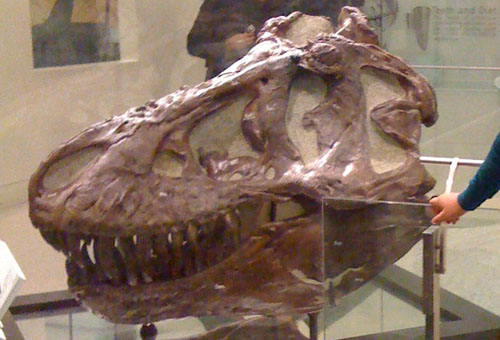
Reality is a skull the size of a huge dog that sits on the fourth floor of the Natural History Museum in New York City. It is dark brown and the crevices are filled with stone. It is dead, and has been dead for a long time. But it was once a real, living animal, and even now, on an atomic level, there is not much difference between it and I.
Fantasy is how we give it flesh, give it skin, give it color and life. With fantasy it can walk again. It can run. It can roar.
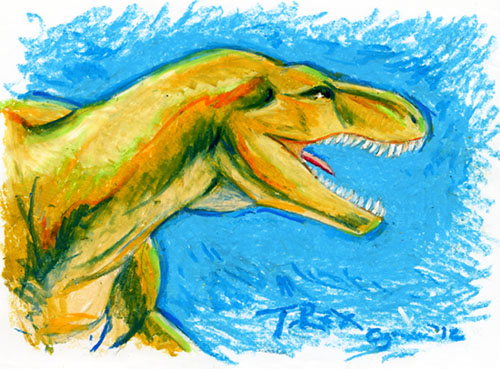
Goldeen Ogawa loves all kinds of dragons, be they dinosaurs or fantastical lizards. She is a practical atheist, but has lots of imaginary friends that are perfectly real… to her.
Comments, responses and/or refutations can be sent to goldeenogawa@gmail.com, or posted in your own blog and tweeted to @GrimbyTweets.
